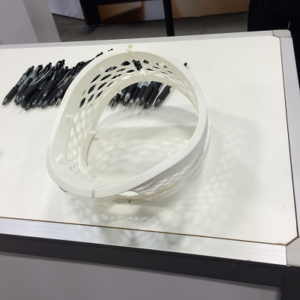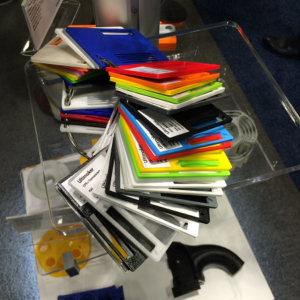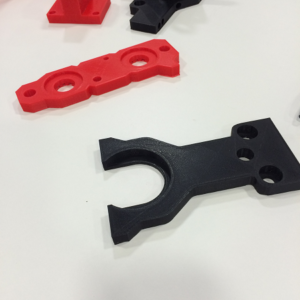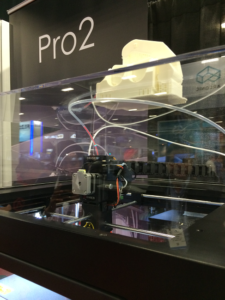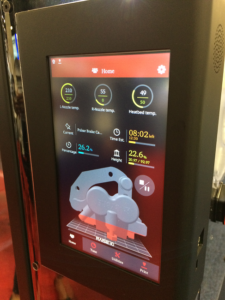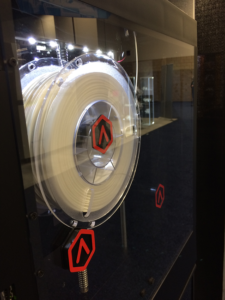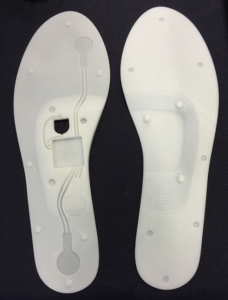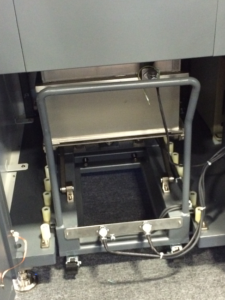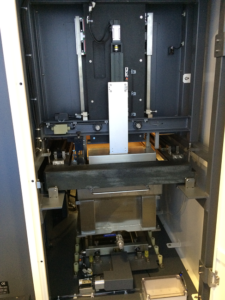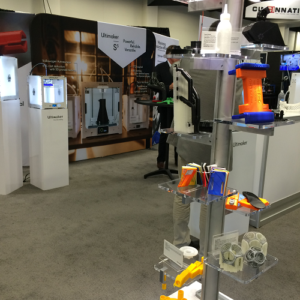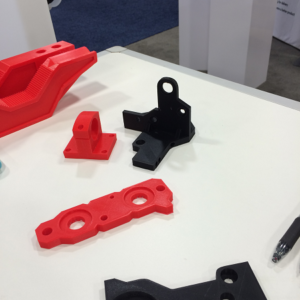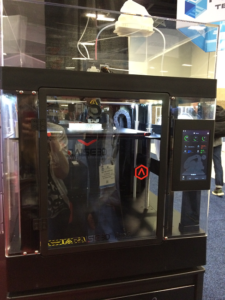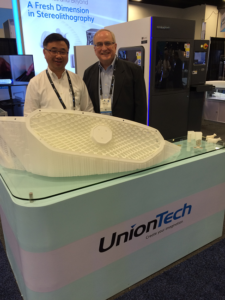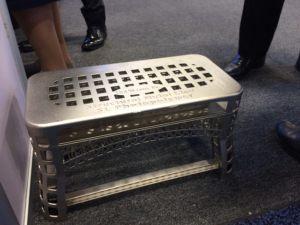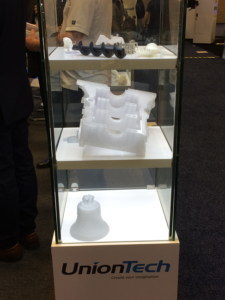 This year’s RAPID + TCT ended only a few days ago in Fort Worth, Texas, and we’ve been busily sharing with you all of the many innovations we witnessed and information we gleaned from the event’s fascinating keynotes, product introductions, and on-site conversations as North America’s largest 3D printing-centered show was home again to many overarching themes in the industry.
This year’s RAPID + TCT ended only a few days ago in Fort Worth, Texas, and we’ve been busily sharing with you all of the many innovations we witnessed and information we gleaned from the event’s fascinating keynotes, product introductions, and on-site conversations as North America’s largest 3D printing-centered show was home again to many overarching themes in the industry.
More than 300 companies exhibited at RAPID 2018, and while we did a fair amount of walking the show floor, we unfortunately were not able to visit every single one. However, I was able to spend time with several great exhibitors at the show, including Ultimaker, displaying its new S5 3D printer; Raise3D, with its new Pro2 series; and China-based UnionTech, which was at the show with its PILOT commercial series.
Ultimaker
At Ultimaker’s booth, I spoke with John Kawola, the President of Ultimaker North America, about the steps the company is “experiencing in offering our technology to the professional market,” such as introducing the professional S5 and forming collaborative alliances with several global material companies to increase the number of engineering composites and plastics that will work with its portfolio. Lots of companies in varying fields are purchasing pellet materials for 3D printing now, and Ultimaker is helping them get in on the action.
“I think a lot of chemical companies – their customers are asking about it,” Kawola said about 3D printing. “Now all of the big names, like SABIC and DSM, want in.
“We’re making it easier for those companies to offer filament for 3D printing. They know materials, we know 3D printing.”
 The company’s powerful and versatile new S5 3D printer, with a build volume of 330 x 240 x 300 mm, dual extrusion, and an enclosed front with tinted glass doors, is, according to Kawola, a “further extension” of the Ultimaker 3, and offers more advanced materials capabilities, such as nylon and carbon-filled.
The company’s powerful and versatile new S5 3D printer, with a build volume of 330 x 240 x 300 mm, dual extrusion, and an enclosed front with tinted glass doors, is, according to Kawola, a “further extension” of the Ultimaker 3, and offers more advanced materials capabilities, such as nylon and carbon-filled.
“All of these things happening started with the S3,” Kawola told me.
At RAPID, the S5 was busily 3D printing an automotive disc brake using the company’s new Tough PLA material, which is available for purchase immediately. Because it’s hard and inexpensive, PLA is one of the most commonly used 3D printing materials, but, in the 3D printing world, hard and tough are not the same thing. Toughness, in materials science terms, is a material’s ability to absorb energy and deform without fracturing; this property is also defined as a material’s fracture resistance when under stress.
 The company’s new material formulation, which is now the default material being shipped with the S5, is made by combining PLA with properties of ABS, such as its impact strength. The material is compatible with Ultimaker’s Breakaway and PVA support materials, and is great for easy, reliable 3D printing of larger sized technical models.
The company’s new material formulation, which is now the default material being shipped with the S5, is made by combining PLA with properties of ABS, such as its impact strength. The material is compatible with Ultimaker’s Breakaway and PVA support materials, and is great for easy, reliable 3D printing of larger sized technical models.
According to Kawola, that “feel-good factor” comes from prototyping with something, and then end up being able to use it later down the road. Tough PLA makes this possible.
Kawola tells me that Ultimaker will be introducing more materials in the coming months, primarily with some of its new material partners. Both the Ultimaker S5 and Tough PLA material are available through the company’s network of global partners including Dynamism.
Raise3D
At the Raise3D booth, I met with Vice President of Marketing Patrick Rettew, and Marketing Manager Nadia Yaakoubi. Rettew describes the company as “customer-driven.”
The company’s industrial yet user-friendly Pro2 series, introduced in March, were developed as a way to increase the use of flexible manufacturing in the industry. According to Rettew, the “beauty of this paradigm shift” is customization, and that companies can thrive – if they want to – by using 3D printing.Both the 12″ x 12″ x 12″ Pro2 and the 12″ x 12″ x 24″ Pro2 Plus feature direct drive dual extruders with retracting nozzles, 32-bit motion control, and safe, quiet operation, thanks to a new HEPA filter. The machines are enclosed, so they can control the internal temperature really well, and it’s easy to lift the top off when working with PLA material.“We like to consider ourselves problem solvers,” he explained.
The 3D printers have aluminum frames, wireless compatibility, and remote monitoring so you can see how your print, or even multiple prints in a number of locations, is progressing. High precision is ensured due to the use of optical sensors, rather than mechanical, in the Pro2 series, and Rettew told me that there are “stringent QC measures in place” in order to ensure that all of the company’s 3D printers are high quality.
A magnetic build plate, which provides even heating for excellent warping prevention, is easy to remove, and the 3D printers feature spool run-out sensors and an automatic print resume function, in case there’s a problem with the power during printing.
With a 0.01 mm resolution and the ability to achieve high temperature 3D printing up to 300°C to accommodate a wide range of materials, Raise3D’s newest series answers the question Rettew says the company always asks itself – how can we make it easier for our customers?
“It’s important that we built such a fine printer,” Rettew says, noting that the Pro2 series was made to run 365 days a year, 7 days a week, 24 hours a day. “We don’t do a lot of promotion, but we still attract attention.”
Due to the high torque of the 3D printers, they can handle bigger spools of material, and a wider variety of materials as well.
Each one also features a 7″ computer touchscreen, which I can attest is very easy to read, that allows you to wirelessly send STL files to the 3D printer; these files will then automatically convert to the necessary format, thanks to Raise3D’s complimentary IdeaMaker slicing software.
Raise3D’s Pro2 and Pro2 Plus 3D printers are perfect for small batch manufacturing, like the types of jobs defense contractors and engineers may perform, and it’s actually possible to print finished parts, since the machines can fabricate larger pieces.
- Large print, with Nadia Yaakoubi for scale.
The company prides itself on helping other companies find solutions to issues they’re having, which is why Raise3D will always “inquire about their business – we care because we’re about solving problems.”
One example is a tough challenge Raise3D collaborated on recently, which resulted in the creation of a UL-approved, fire-resistant ABS material, which did not exist before now.
“That’s what we do,” Rettew said. “We solve challenges.”
UnionTech
Right next to Raise3D at RAPID, stereolithography leader UnionTech had its booth…though don’t refer to the technology as SLA around US subsidiary UnionTech’s General Manager Jim Reitz, who prefers to call it SL. Reitz drops the industry-standard ‘A,’ which stands for apparatus, because he believes that the term SLA “blurs the lines” and “dumbs it down.”
“I think the new wave of innovation will come from people who integrate existing technology with new technology,” Reitz said.
With UnionTech’s industrial SL printers, the imaging comes from below, not from above, which is what differentiates the machines from other SLA 3D printers.
“There are so many new ways to make things, but SL has the widest range of materials and sizes.”
UnionTech recently opened a new facility in St. Charles, Illinois, and its parent company had its PILOT series on display at RAPID, showcasing the 450 x 450 x 400 mm 450 3D printer – the largest in the commercial series – at its booth and the smaller 250 at the DSM booth.
 The company’s new RSPro 1400, which wasn’t on display at RAPID and will begin shipping late Q3 2018, features dual lasers, auto calibration, and a scanning system, along with a carbon fiber-reinforced blade for 3D printing large-scale parts with no visible lines. The 3D printer, with a 1.4 x 0.7 m platform, is targeted more towards production markets in automotive, consumer goods, and foundries.
The company’s new RSPro 1400, which wasn’t on display at RAPID and will begin shipping late Q3 2018, features dual lasers, auto calibration, and a scanning system, along with a carbon fiber-reinforced blade for 3D printing large-scale parts with no visible lines. The 3D printer, with a 1.4 x 0.7 m platform, is targeted more towards production markets in automotive, consumer goods, and foundries.
But both the 250 and 450, which are “cost-effective” and can be used to create “really good-looking parts,” were designed specifically for 3D printing users that could use their industrial capabilities at a lower cost.
Reitz said, “How do you build a machine more cost-effective than others?”
The answer, at least when it comes to leveling, is to keep things simple with a motorized cart and elevator located below the machine. A granite recoater frame and side rails offer increased recoating stability, and this simple material delivery system also features a built-in heating element.
According to Reitz, UnionTech’s competitors use RFID, and constantly have bottles pumping in and out. But because UnionTech manufactures open source 3D printers, the company can avoid this and keep things cost-effective, while widening the market segment for users, because its 3D printers work with any 350 nanometer material; for example, Somos material has been qualified for use with UnionTech since 2002.
“We see this making SL approachable for those who thought it was too expensive before,” Reitz explained, and said that the company was “doing big things on the commercial side to make this technology more approachable.”
Reitz also explained that UnionTech keeps its costs down by making sure parts are more lightweight – it manages this by using TetraShell software from Materialise to hollow out its reinforced parts. He also said that other 3D printers, such as HP’s MJF technology, have material costs because they have to print a support layer for each part layer, which UnionTech doesn’t do.
The PILOT series of 3D printers by UnionTech, which can perform on par with production SL systems and include a full range of commercial SL materials, starts at under $100,000.
Check out more pictures from my visits with Ultimaker, Raise3D, and UnionTech at RAPID below:
- UnionTech at RAPID 2018 [Image: Sarah Saunders]
Discuss this and other 3D printing topics at 3DPrintBoard.com or share your thoughts below.
[All photos: Sarah Saunders unless otherwise noted]Subscribe to Our Email Newsletter
Stay up-to-date on all the latest news from the 3D printing industry and receive information and offers from third party vendors.
You May Also Like
3D Printing Unpeeled: New Arkema Material for HP, Saddle and Macro MEMS
A new Arkema material for MJF is said to reduce costs per part by up to 25% and have an 85% reusability ratio. HP 3D HR PA 12 S has been...
3D Printing News Briefs, January 20, 2024: FDM, LPBF, Underwater 3D Printer, Racing, & More
We’re starting off with a process certification in today’s 3D Printing News Briefs, and then moving on to research about solute trapping, laser powder bed fusion, and then moving on...
3D Printing Webinar and Event Roundup: December 3, 2023
We’ve got plenty of events and webinars coming up for you this week! Quickparts is having a Manufacturing Roadshow, America Makes is holding a Member Town Hall, Stratafest makes two...
Intuitive Machines Debuts $40M Hub for Lunar Ambitions and 3D Printing Tech
Best known for its pioneering work in lunar exploration and its development of the Nova-C lunar lander, Intuitive Machines (Nasdaq: LUNR) has marked yet another significant milestone. The leading space...


